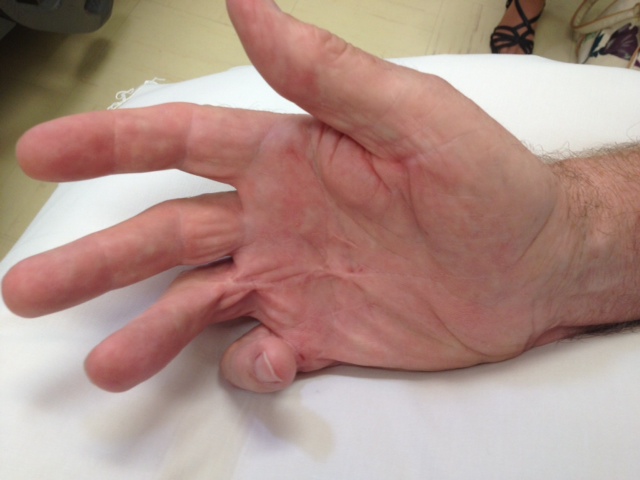Indications
1. Significant functional impairment
2. PIPJ contracture
- originally thought to intervene early
- Macfarlane showed residual FFD always about 30o
- may need to release check rein ligaments / accessory collateral ligaments
3. MCPJ contracture >30o
4. Trigger fingers
- must do limited fasciectomy
- otherwise may get exacerbation
5. CTS
- treat dupuytren's 1st then carpal tunnel if doesn't settle
Contraindications
Advanced RA
Trophic changes due to vascular insufficiency
Unfit for GA
Risk for Recurrence
Diathesis
- Garrod's pads highest risk
- foot and penis involvement
Family History
Bilateral / Radial and ulna involvement / multiple digits
Males
Young patients and patients > 75
Options
Fasciotomy
Partial Fasciectomy
Complete Fasciectomy
Dermatofasciectomy and STSG
Amputation
Fasciotomy
Division of fascial cord
- Temporary method to relieve a severe MCPJ contracture
- not definitive therapy
- not in digits because high risk of neurovascular injury
- useful in elderly patients
- results are better with dense mature cords
Partial Fasciectomy

Most common procedure
Recurrence rates of 50%
- need for repeat surgical procedure is only 15%
Technique
Longitudinal incision with Z plasty at end of case
- probably better with severe contracture as allows skin closure
- easier to protect NV bundles
- z at 60o
Careful flap elevation
- easy to button hole through skin
Dissection of NV bundles
- under then over spiral bands
Resection of diseased tissue
PIPJ contracture > 30o
- MUA
- released check rein / accessory collateral / volar plate / capsulotomy / flexor sheath
- note that a extended finger which does not flex is more debilitating than a FFD
Skin gaps
- due to large contractures
- FTSG
- McCash open technique (secondary healing)
Closure
- let down tourniquet for haemostasis
- consider drain
- check finger vascularity
Post-op
POP backslab in POSI
Wound check at 7 days
ROS 2 weeks
Night splint in extension for 3/12
Complete Fasciectomy
Abandoned due high complication rate
- does not completely prevent recurrence of the disease
Dermatofasciectomy & FTSG
Indications
- recurrent disease
- young with diathesis / aggressive disease
- Recurrence under grafts very rare (Hueston)
- the FTSG as a fire break
Amputation
Rarely necessary
- may be indicated if severe PIPJ flexion
- skin from involved finger may be used to cover palmar skin defect
- finger is filleted & skin folded into palm as pedicle with neurovascular bundles
Adjunctive Procedures
Trigger Fingers
Excise diseased fascia with release of the A1 pulley
Pulley release without local diseased fascial excision
- may instigate a rapid progression of the Dupuytren's disease
Carpal Tunnel Syndrome
Prophylactic CTD at time of fasciectomy is unwise
- accelerated scar formation may cause poor result
Partial Fasciectomy with CTD at later date
Complications
Haematoma
- can be a problem for the skin
- lead to necrosis
Vascular Impairment/ Flap Necrosis
- finger white at end of procedure
- often due to vessel stretched after significant release
- bend fingers, leave tourniquet down
- papaverine on vessels as antispasmodic
- warm hand
- inspect vessels for damage
- wait
Nerve Injury
Reflex sympathetic dystrophy
